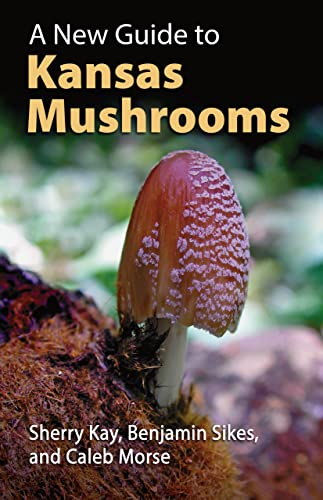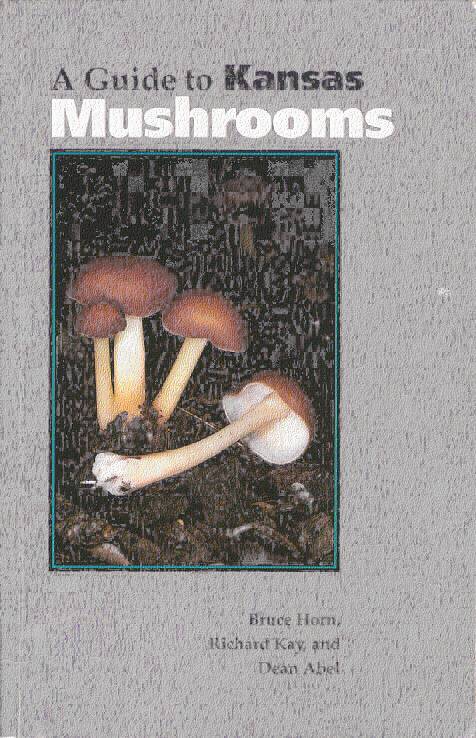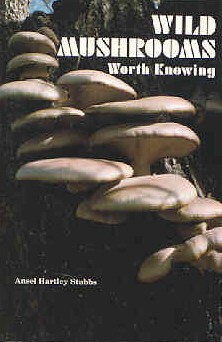Kansas Mushroom Books
A New Guide to Kansas
Mushrooms
by Sherry Kay, Benjamin Sikes, and Caleb Morse (2022)
A Guide to Kansas
Mushrooms
by Bruce Horn, Richard Kay, and Dean Abel (1993)
A Checklist of Kansas Mushrooms
compiled
by Richard Kay
Wild Mushrooms Worth Knowing
by
Ansel
Hartley Stubbs
A New Guide to Kansas Mushrooms
by Sherry Kay, Benjamin Sikes, and Caleb Morse
A New Guide to Kansas Mushrooms was published on September 15, 2022. It is available from the publisher, University Press of Kansas, and on
Amazon.
This is the revised edition of A Guide to Kansas Mushrooms.
Originally published in 1993, A Guide to Kansas Mushrooms went out of print in 2017. Original author Richard Kay suggested his wife, Sherry Kay, could assume the undertaking of revising the book, collaborating with him working as a consultant. After Richard’s death in 2018, Sherry later added two coauthors, Benjamin Sikes and Caleb Morse, to complete the task.
Kay, Sikes, and Morse have revised this new edition to account for the variety of ways mycology has changed in the last twenty-five years, while holding to its original purpose as a guide for active mushroomers. Primarily, A New Guide to Kansas Mushrooms highlights the upheaval in taxonomy caused by advances in molecular genetics: an estimated 25 percent of fungal names included in the original guide have changed since 1993. Second, the list of mushrooms found in Kansas has expanded and the new edition will add 50 species to the 150 described in the original guide. All anthology entries have been updated to reflect these changes in the field, and the essays have also been edited, reduced, or expanded to include updated information as well as brand-new material. The outdated genus-level classification of fungi has been replaced by two cladograms—diagrams that illustrate how organisms branch off from their last common ancestors.
This revised edition provides a wealth of new material on Kansas mushrooms that will aid and fascinate both newbies and seasoned mycophiles and includes information on online resources and notes on how to grow mushrooms in Kansas. While the book fully treats 200 species, readers will be able to identify 320 different macrofungi using the keys and discussions. Additionally, the book introduces readers to fascinating, common slime molds (myxomycetes). A New Guide to Kansas Mushrooms incorporates new understanding of fungal taxonomy that has been largely unearthed by genetic tools over the past three decades, highlights key taxa, and includes a life list of the more than 1,200 species now cataloged from Kansas—nearly twice the number known at the time of the first edition.
↑
A Guide to Kansas Mushrooms
by Bruce Horn, Richard Kay, and Dean Abel
This first-rate guide written about Kansas mushrooms, published in 1993 by University of Kansas Press, was recognized by Harley Barnhart in Mushroom the
Journal as one of the best eight field guides for beginning mushroomers.
It provides Latin and common names and descriptions of 235 species found
in the state, including 150 photographs of common and uncommon species.
There is a nontechnical key for identification, a calendar of fungal fruiting
seasons, a list of 548 species that have been located in Kansas, and even
a guide to the pronunciation of Latin names.
Three members of the Kaw
Valley Mycological Society collaborated on this book. Bruce Horn
is a microbiologist with the U.S. Department of Agriculture in Georgia
and the author of several scientific publications on fungi. Richard
Kay is a retired professor of history at the University of Kansas with
a specialty in Dante, also author of A Checklist of Kansas Mushrooms,
and a skilled amateur mycologist. Dean Abel is an electron microscope
technician in the Biology Department at the University of Iowa, and well
known for his many years as chairman of the North American Mycological Association (NAMA) Photography Contest.
This book may still be available as a used copy on Amazon.
↑
A Checklist of Kansas Mushrooms
compiled by Richard Kay
This small inexpensive
checklist is an annotated inventory of 727 species reported from Kansas.
Each mushroom is listed by its scientific Latin name. Below this
are synonyms, common English names, the witnesses reporting the finds,
and which of the field guides (Arora, Huffman, Lincoff & Peterson)
describe the mushroom.
The Index of Latin Names
containing 2,758 entries, all main entries by genus and species, and all
synonyms by genus and species. Also included is A Systematic List
of Kansas Fungi which list all 727 Kansas species according to their place
in the fungal kingdom.
The checklist is especially
helpful when Arora or some other national field guide leads you to think
you have collected a rare or exotic specimen in Kansas; you can quickly
discover whether the species has been reported here before.
↑
Wild Mushrooms Worth Knowing
by Ansel Hartley Stubbs
Wild Mushrooms of the Central
Midwest, the first guide to Kansas mushrooms, was written by the late
Ansel Hartley Stubbs and published it 1971. The first two printings
of the book were published by the University Press of Kansas. The
book was well received in Kansas, as Ansel lived in Kansas City and was
acquainted with many of the members of the Kaw Valley Mycological Society
In 1980 the book was republished
by The Lowell Press of Kansas City under the name Wild Mushrooms Worth
Knowing. The latter name is perhaps more appropriate as the mushrooms
described can be found nearly everywhere in the country.
Although both books are
out of print, there are probably copies still available. The latest
publication contains more than 60 full-color photographs of mushrooms,
with a beautiful picture of Pleurotus ulmarius (now known as Hypsizygus
ulmarius) on the cover taken by longtime KVMS member Felicia Bart.
Included are easily understandable descriptions with black and white drawings
of most of the common mushrooms. There is a full section of recipes
and a handy identification chart.
As newer field guides have
been developed, this book is no longer a "must have" for identification,
but as the earliest field guide for the midwest, it qualifies as a collector's
item for anyone interested in Kansas mushrooms, and a good addition to
your mushroom library.
↑




